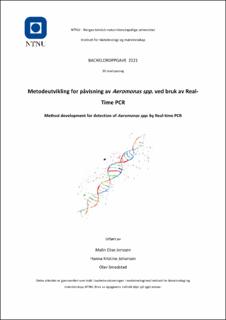| dc.contributor.advisor | Hoel, Sunniva | |
| dc.contributor.author | Jenssen, Malin Elise | |
| dc.contributor.author | Johansen, Hanna Kristine | |
| dc.contributor.author | Smedstad, Olav | |
| dc.date.accessioned | 2021-09-25T16:13:35Z | |
| dc.date.available | 2021-09-25T16:13:35Z | |
| dc.date.issued | 2021 | |
| dc.identifier | no.ntnu:inspera:81708024:81953166 | |
| dc.identifier.uri | https://hdl.handle.net/11250/2782636 | |
| dc.description.abstract | Hensikten med bacheloroppgaven var å utvikle en metode for påvisning av presumptive Aeromonas etter oppdyrking på stivelse ampicillin agar (SSA), ved bruk av real-time PCR. Metoden vil benyttes som et supplement til tidkrevende konfirmeringstester i NMKL metode 150.
PCR-analyser ble satt opp for 20 ulike Aeromonas stammer og 30 «non-targets». Utfordringen var å finne optimale reaksjonsbetingelser for amplifisering av DNA fra Aeromonas, uten å amplifisere DNA fra andre bakterier. Endringer i primerpar og temperatur for annealing utgjorde de viktigste parameterne som ble endret for å optimalisere metoden.
Et utvalg av 20 stammer fra totalt 9 forskjellige Aeromonas-arter, og 30 stammer fra totalt 26 forskjellige «ikke-Aeromonas»/«non-targets» ble dyrket opp og DNA ble isolert fra alle stammene. En rekke forsøk ble utført for å teste ut og optimalisere reaksjonsbetingelsene for en real-time PCR.
Primerparene gyrB_F/gyrB_R og gyrB7F/gyrB9R ble testet som Aeromonas-spesifikke primere. Temperaturer for annealing i reaksjonen ble testet fra 60 °C til henholdsvis 66 °C og 64 °C for de to primerparene, der målet med økt temperatur var å øke spesifisiteten til primerene. SYBR Green ble brukt som fargestoff for å detektere mengden dobbelttrådet DNA i løpet av PCR-analysen.
Forsøkene med gyrB_F og gyrB_R resulterte i amplifisering av alle Aeromonas-stammene, men også amplifisering av en høy andel «non-targets». Ved 60 °C annealing ble 28 av 30 «non-targets» amplifisert, 25 av 30 ble amplifisert ved 62 °C, 22 av 22 ble amplifisert ved 64 °C, mens for 66 °C ble 20 av 22 stammer amplifisert.
Forsøkene med gyrB7F og gyrB9R ga en mindre optimal amplifisering av Aeromonas, ved at stammene ble amplifisert med en høyere CT-verdi enn for det første primerparet. Ved 60 °C annealing fikk Aeromonas-stammene en gjennomsnittlig CT-verdi på 13,45 for primerpar gyrB_F og gyrB_R, mens med primerpar gyrB7F og gyrB9R ble gjennomsnittlig CT-verdi på 20,33. Analysene med primerpar gyrB7F og gyrB9R resulterte i en betydelig lavere andel amplifiserte «non-targets», spesielt ved en høyere annealing-temperatur. Ved 60 °C annealing ble 10 av 27 «non-targets» amplifisert, mens ved 64 °C annealing ble kun 4 av 11 stammer amplifisert. Det ble tatt utgangspunkt i at stammene som ikke ble amplifisert ved 60 °C heller ikke ville bli amplifisert ved 64 °C annealing, og ble derfor utelukket fra videre forsøk.
Ut fra PCR-analysene kan det konkluderes med at en reaksjon med primerne gyrB7F og gyrB9R, med 64 °C annealing og en «cut-off» i CT-verdi på 30 sykluser kan benyttes for å påvise presumptive Aeromonas, med 2 % falske positive påvisninger og 4,5 % falske negative påvisninger. Videre utvikling av metoden er nødvendig for en mer spesifikk deteksjon for Aeromonas. | |
| dc.description.abstract | The purpose of this bachelor thesis was to develop at method for detection of presumptive Aeromonas after cultivation on ampicillin agar (SSA), by using real-time PCR. The method will supplement the time-consuming confirmation tests in NMKL method 150.
PCR analyses was set up for 20 different Aeromonas strains and 30 “non-targets”. It proved challenging to find optimal reaction conditions for amplifying Aeromonas, without also amplifying DNA from other bacteria. Changes in the primer pair and the annealing temperature were the most important parameters that were varied to optimise the method.
A selection of 20 strains from a total of 9 different Aeromonas-species, and 30 strains from 26 different “non- Aeromonas”/”non-targets” were cultivated and their DNA isolated. A series of experiments were conducted to test and optimise the reaction conditions for a real-time PCR.
The primer pairs gyrB_F/gyrB_R and gyrB7F/gyrB9R were tested as Aeromonas-specific primers. Temperatures for the annealing stage of the reaction were tested from 60 °C to respectively 66 °C and 64 °C for the two primer pairs, with the goal of increasing their specificity. SYBR Green was used as a dye to detect the amount of double stranded DNA during the PCR analysis.
The experiments with gyrB_F and gyrB_R resulted in amplification of all Aeromonas strains, but also amplification of a large part of the “non-targets”. At 60 °C annealing, 28 out of 30 ”non-targets” were amplified, 25 out of 30 were amplified at 62 °C, 22 out of 22 were amplified at 64 °C, and at 66 °C 20 out of 22 strains were amplified.
The experiments with gyrB7F and gyrB9R resulted in a less optimal amplification of Aeromonas, giving the strains a higher CT value than what they reached with the first primer pair. Annealing at 60 °C gave the Aeromonas strains an average CT value of 13,45 for primer pair gyrB_F and gyrB_R, while primer pair gyrB7F and gyrB9R gave an average CT value of 20,33. The analyses with primer pair gyrB7F and gyrB9R resulted in amplification of a significant lower share of the “non-targets”, especially at a higher annealing temperature. At 60 °C annealing, 10 out of 27 “non-targets” were amplified, while at 64 °C annealing only 4 out of 11 strains were amplified. An assumption was made that the strains that were not amplified at 60 °C would not be amplified at 64 °C either, and they were therefore excluded from later experiments.
From the PCR analyses a conclusion can be made that a reaction with the primers gyrB7F and gyrB9R, with annealing at 64 °C and a “cut-off” I CT value at 30 cycles, can be used to detect presumptive Aeromonas, with 2 % false positive and 4,5 % false negative detections. Further development of the method is necessary for a more specific detection of Aeromonas. | |
| dc.language | nob | |
| dc.publisher | NTNU | |
| dc.title | Metodeutvikling for påvisning av Aeromonas spp. ved bruk av Real-Time PCR | |
| dc.type | Bachelor thesis | |
